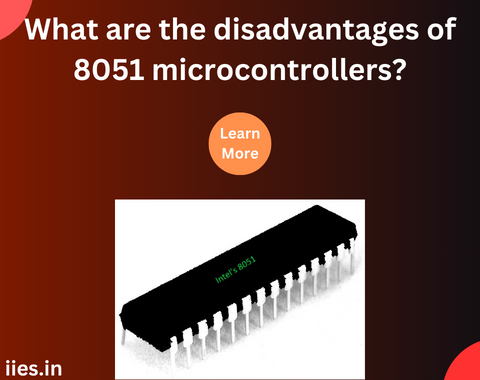
Microcontrollers play a crucial role in the world of embedded systems, providing the brains for a myriad of applications ranging from household appliances to industrial machinery. Among the plethora of microcontrollers available, the 8051 series has long been a staple in the industry. Developed by Intel in the 1980s, the 8051 microcontroller family has enjoyed widespread adoption due to its versatility and reliability. However, like any technology, the 8051 microcontrollers are not without their disadvantages. In this article, we will delve into the limitations and drawbacks of the 8051 microcontrollers.
One of the prominent drawbacks of 8051 microcontrollers is their limited processing power compared to modern alternatives. Originally designed with a focus on simplicity and cost-effectiveness, the 8051 microcontrollers feature a relatively slow clock speed, often ranging from a few kilohertz to a few megahertz.
This limitation can be a significant hindrance when dealing with applications that demand high computational capabilities, such as complex algorithms, signal processing, or advanced control systems. Modern microcontrollers with higher clock speeds and more advanced architectures have largely surpassed the 8051 in terms of raw processing power.
Limited Memory Capacity
Memory constraints are another significant disadvantage of 8051 microcontrollers. The original 8051 architecture typically includes a small amount of on-chip ROM (Read-Only Memory) for program storage and on-chip RAM (Random Access Memory) for data storage. The limited memory capacity can pose challenges when developing complex programs or applications that require a large codebase. This can be particularly problematic in today’s environment where applications are becoming increasingly sophisticated and memory-intensive.
Outdated Instruction Set
The 8051 microcontroller family employs an outdated and less efficient instruction set architecture compared to modern microcontrollers. This older instruction set can lead to less efficient code execution, resulting in slower performance and increased development time for programmers. More contemporary microcontrollers often boast improved instruction sets, providing developers with a more versatile and streamlined programming experience.
Lack of Integrated Peripherals
Unlike more recent microcontrollers, the 8051 family often lacks integrated peripherals. While newer microcontrollers come equipped with a wide array of built-in peripherals such as USB controllers, Ethernet interfaces, and advanced analog-to-digital converters, 8051 microcontrollers often require additional external components to achieve similar functionality. This can lead to increased complexity in circuit design, higher costs, and a larger footprint for the final embedded system.
Limited Availability of Development Tools
Another drawback of the 8051 microcontroller ecosystem is the limited availability of modern development tools. While there are still tools and compilers available for programming 8051 microcontrollers, the support and features provided may not match those available for more contemporary microcontroller platforms. This can make development and debugging processes less efficient, especially for developers accustomed to the advanced toolsets offered by newer microcontroller families.
Higher Power Consumption
Compared to newer microcontrollers designed with power efficiency in mind, the 8051 family tends to have higher power consumption. In today’s world, where energy efficiency is a critical consideration in electronic design, the higher power consumption of 8051 microcontrollers can be a significant drawback, particularly in battery-operated or energy-sensitive applications.
Limited Community Support
While the 8051 microcontroller family has a rich history and a large base of existing projects, the level of community support has diminished over the years. As developers and engineers shift their focus towards more modern microcontroller platforms, finding up-to-date resources, forums, and community support for 8051-based projects can become challenging. This lack of a vibrant community can hinder the learning process and troubleshooting efforts for those working with 8051 microcontrollers.
Limited Connectivity Options
The 8051 microcontroller family was designed in an era where connectivity was not as crucial as it is today. Modern applications often demand seamless integration with various communication protocols such as Bluetooth, Wi-Fi, or Ethernet. Unfortunately, 8051 microcontrollers lack built-in support for these advanced connectivity options. While it is possible to implement these features using external components, the additional hardware can increase system complexity and cost.
Reduced I/O Pins
Another limitation of 8051 microcontrollers is the relatively low number of general-purpose I/O (Input/Output) pins available. In contemporary projects, especially those involving complex interfacing or control systems, a greater number of I/O pins are often required. Newer microcontrollers offer a more extensive range of pins, allowing for more flexible and intricate designs without the need for external components to expand the I/O capabilities.
Inefficient Code Density
The 8051 architecture suffers from inefficient code density, meaning that the same functionality may require more memory space compared to other microcontroller architectures. This inefficiency can be a significant concern when working on projects with tight memory constraints. More modern microcontrollers often feature advanced compiler optimizations and improved architectures that result in better code density, allowing developers to achieve more with less memory.
While the 8051 microcontrollers have served the embedded systems community well for decades, they are not without their limitations. As technology evolves, the disadvantages of 8051 microcontrollers become more pronounced, especially when compared to the capabilities offered by newer microcontroller families. Developers must carefully weigh the pros and cons of using 8051 microcontrollers in their projects, considering factors such as processing power, memory constraints, outdated instruction sets, lack of integrated peripherals, limited development tools, higher power consumption, and diminished community support. In many cases, choosing a more modern microcontroller platform may be a more suitable and future-proof option for meeting the demands of contemporary embedded systems development.
Indian Institute of Embedded Systems – IIES